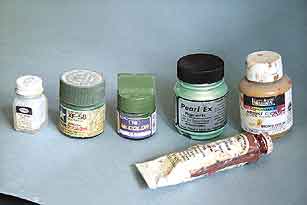
 |
Choosing Paint

There are so many paints on the market, what should I use? What are the properties of various paints? I'll talk about some I've used.
|
Artist acrylics (Liquitex/Golden) You can thin them with water, but it's better to thin with either alcohol or Windex (the blue tint does not affect paint). Airbrush medium is available for airbrushing. Lacquer thinner will react with them, but will result in disgusting gunks of latex. Recommended if you don't build kits very quickly and are in general careful in handling parts. I gave up on these paints because I'm neither. |
Pros:
Cons:
|
|
Modeling acrylics (Tamiya/Gunze/ModelMaster Acryl) You can thin them with water, but shouldn't. It's better to thin them with either alcohol or Windex (the blue tint does not affect paint). You can also thin them with lacquer thinner for ultra fast drying, but lacquer thinner is toxic. Recommended if you're starting out. |
Pros:
Cons:
|
|
Enamels (Tamiya/Testors) You can thin them with mineral spirits (i.e. "paint thinner"), or lacquer thinner which is more toxic but decreases drying and curing time. Recommended for touch up jobs. |
Pros:
Cons:
|
|
Lacquer(Floquil/Automotive paints/Gunze Mr. Color) I love it
due to its quickness of drying and curing, and its tough film. It can be sanded
after it dries. Gunze offers two different types of thinner for it, namely
Mr. Thinner and Mr. Color Leveling Thinner. The latter is basically Mr. Thinner
with some retarder added in. The retarder slows drying and serves 2 purposes:
(1) makes it easier to hand brush (so that the brush strokes will hopefully
level off and disappear before the paint dries). (2) makes it easier to airbrush.
You can thin Mr. Color with lacquer thinner or Mr. Thinner, but unless your paint is very thin, Mr. Color dries in mid-air
before it hits the paint surface, causing either strings or grains. I get
much better results with color leveling thinner. I recommend getting the color
leveling thinner even if it's slightly more expensive. If you can't, get a
bottle of mild retarder from Gunze, and add a few drops to your thinner/color
mixture. |
Pros:
Cons:
|
Mixing Paint
I use dead or cheap brushes to transfer and mix paints. The big cons is hair can come off and land on your models, but brushes hold paint well. Sometimes when I need to transfer paint at a ratio, I either eyeball and pour from the jar, or "dip my brush in red twice, and yellow once, mix..."
Cleaning Paint
The traditional wisdom is keep 2 or 3 jars of thinner. Jar 1 is the dirtiest thinner, you swirl and twist your brush in it to rinse off most of the paint. Then rinse the brush in jar 2 and your brush is mostly clean. At Jar 3 your brush is completely clean.
Using Different Paints
It's advantageous to keep several different lines of paints. You can paint acrylics on top of enamels, and wipe off any mistakes with thinners for acrylics without affecting the enamel layers, which makes detailing relatively painless. Lacquer thinner will dissolve both enamels and acrylics, thinners for enamels however does not affect acrylics (and lacquer) and vice versa (rumors are that some acrylics are affected by mineral spirits - test first - I've never encounter such acrylics) Therefore, anything can go on top of lacquer, enamels can go on top of acrylics and vice versa.
Glossiness
To get a good finish you want to be able to control the glossiness of your paint. Most lines of paints have glossy and flat versions, e.g. Tamiya, Gunze. But flat yellow can be gotten from gloss yellow by adding a flat base, so there is no need to buy both. In artist acrylics, you mix the paint with matte medium.
You can also get an ultra glossy surface by coating the paint surface with Future Floor Wax. You can brush it on as it self-levels very well, or your can airbrush it straight out of the bottle. It can be thinned like an acrylic paint. You can also get a flat clear coat by adding flat base to Future.
Special paints
Pearl-Ex pigments: These are produced by Jacquard and available in many art stores (or Misterart) These are powdered pigments, so you need to add a binding agent and some thinning agent to use it. You can mix them with paint - the effect is variable depending on the opaqueness (how well the paint covers) of your paint, and the quantity of powder you need to add vary accordingly. Don't try to add too much however, because it can clog your airbrush. You can also add them to clear colors and achieve a wide variety of shiny pearlescent effects. I have also drybrushed the powder on with oil drying agents.
Maziora colors: These are proprietary paints for automotives. In the US they're marketed as Chromallusion paints. These colors can change colors at different angels, providing some very interesting effects. The gradation in the color change is more interesting and will give nice hues (difficult to describe without a picture), and looks better than the Duo colors offered by Jacquard. Gunze offered 5 of the 9 colors, but they're very expensive (like $20 for a small bottle.)